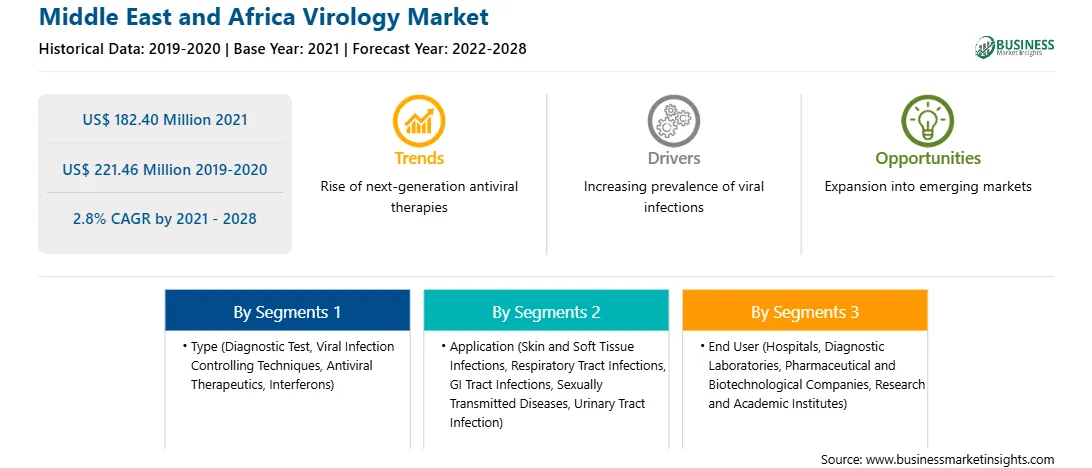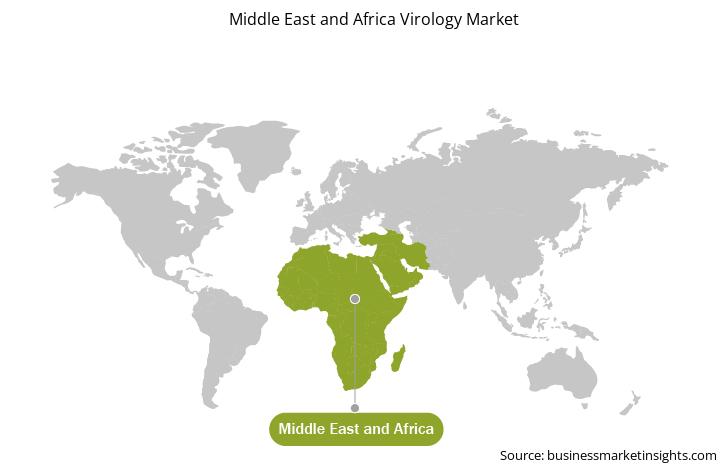The Middle East and Africa Virology market includes the consolidated markets for UAE, Saudi Arabia, South Africa, and rest of Middle East and Africa. The increasing viral outbreaks, increasing number of travelers in Middles East are driving the growth of virology market. in addition, increasing prevalence of HIV, and other epidemics such as Ebola in Africa creating opportunities for virology market. In addition, Saudi Arabia is one of the countries that could have a severe impact during the COVID-19 pandemic due to inbound travel activities such as the Hajj and Umrah. Saudi Arabia is expected to host up to 30 million pilgrims by 2030, which increases the risk of an epidemic and underlines the need for public health authorities to adapt to new ways of responding to outbreaks to prevent the spread of any upper respiratory tract viruses during these times. After discovering the MERS-CoV, the Saudi Ministry of Health (MoH) has promptly established the Saudi Center for Disease Control and Prevention (SCDC), which is now operational and in the frontline of the country's response to COVID-19. In addition, the Saudi MoH launched the National Health Laboratory (NHL), particularly providing advanced diagnostics to infectious diseases with high biocontainment laboratories. Additionally, the Saudi MoH has designated more than 25 regional hospitals for the isolation and treatment of MERS patients. These hospitals were well prepared to treat COVID-19 patients. In addition, Saudi Arabia is also one of the signatories on the WHO International Health Regulation and has been reporting on pandemic preparedness since and following the WHO policies on infection prevention and control. Thus, well-established healthcare infrastructure and well-structured pandemic preparedness policies are driving the virology market in coming years. Continuous requirement for cost-effective products is the major factor driving the growth of the MEA virology market.
Economic uncertainties and ongoing conflicts are worsening the condition in the region. For instance, countries like Syria, Libya, and Yemen are suffering violent conflict and cannot implement any public health measures. Iran was in a deep economic recession due to the US sanctions. Additionally, tightened financial condition is also decreasing the economic activities in the region. COVID-19 is the second coronavirus outbreak that has affected the Middle East, following the MERS-CoV reported in Saudi Arabia in 2012. Many countries are facing a shortage of testing kits in the region. Considering this, many government organizations are coming forward to help countries with a lack of resources. For instance, in September, The United Nations Children’s Fund (UNICEF) delivered around 115,800 Covid-19 test kits to help mitigate the Covid-19 pandemic in Nigeria. Also, the countries in the region are collaborating with international players to increase the testing capacity. In addition, the substantial direct health, and economic impacts of the Ebola epidemic in Guinea, Liberia, and Sierra Leone, diverted basic health care and government services to the outbreak, resulting in serious under-provision of health and social care. Economic growth also slowed significantly due to reduced financial investments and productivity levels during and after the outbreak. As per the Global Fund Organization, across 24 countries in Africa, only 11% of health facilities could conduct COVID-19 antigen rapid diagnostic tests, and only 8% could conduct PCR tests. Before the COVID-19, Lassa Fever was the priority, with the annual incidence of around 300,000-500,000 cases of Lassa Fever, with 5,000 related deaths in West Africa. However, COVID-19 has diverted all the rescores in handling the pandemic has impeded the growth of the other virus infections.

Strategic insights for the Middle East and Africa Virology provides data-driven analysis of the industry landscape, including current trends, key players, and regional nuances. These insights offer actionable recommendations, enabling readers to differentiate themselves from competitors by identifying untapped segments or developing unique value propositions. Leveraging data analytics, these insights help industry players anticipate the market shifts, whether investors, manufacturers, or other stakeholders. A future-oriented perspective is essential, helping stakeholders anticipate market shifts and position themselves for long-term success in this dynamic region. Ultimately, effective strategic insights empower readers to make informed decisions that drive profitability and achieve their business objectives within the market.

| Report Attribute | Details |
|---|---|
| Market size in 2021 | US$ 182.40 Million |
| Market Size by 2028 | US$ 221.46 Million |
| Global CAGR (2021 - 2028) | 2.8% |
| Historical Data | 2019-2020 |
| Forecast period | 2022-2028 |
| Segments Covered |
By Type
|
| Regions and Countries Covered | Middle East and Africa
|
| Market leaders and key company profiles |
The geographic scope of the Middle East and Africa Virology refers to the specific areas in which a business operates and competes. Understanding local distinctions, such as diverse consumer preferences (e.g., demand for specific plug types or battery backup durations), varying economic conditions, and regulatory environments, is crucial for tailoring strategies to specific markets. Businesses can expand their reach by identifying underserved areas or adapting their offerings to meet local demands. A clear market focus allows for more effective resource allocation, targeted marketing campaigns, and better positioning against local competitors, ultimately driving growth in those targeted areas.

The virology market in MEA is expected to grow from US$ 182.40 million in 2021 to US$ 221.46 million by 2028; it is estimated to grow at a CAGR of 2.8% from 2021 to 2028. Virology is among the significant sections of the healthcare system. It has an extensive application in vaccine development, diagnostics, treatment therapies, and others. The market players are constantly involved in product innovations and developments to sustain the competition in the market. They explore various scopes for product innovations. For instance, for COVID-19, market players are investing significantly in the development of vaccines, testing kits, and other related products and services. Below are a few of the market developments related to the virology market:
• In August 2021, the U.S. Food and Drug Administration (FDA) approved the first COVID-19 vaccine known as the Pfizer-BioNTech COVID-19 Vaccine. It will be marketed as ComiRNAty (Koe-mir’-na-tee). The vaccine is intended to prevent COVID-19 disease in individuals aged 16 years and above. It is also available under emergency use authorization (EUA).
• In April 2021, CerTest Biotec launched its CE-marked COVID-19 diagnostic test for the BD MAX System.
• In May 2020, Bio-Rad received FDA approval for emergency use authorization for the COVID-19 total antibody test.
• In May 2020, Aalto Bio Reagents launched New Recombinant Eukaryotic SARS-CoV-2 S1-S2 Spike Proteins.
Thus, such active participation of the market players by product innovations and favourable governments support is expected to bolster the growth of the MEA virology market.
The MEA virology market is segmented on the bases of type, application, end user, and country. Based on type, the market is segmented into diagnostic test, viral infection controlling techniques, antiviral therapeutics, and interferons. The antiviral therapeutics segment dominated the market in 2020, and viral infection controlling techniques segment is expected to be the fastest growing during the forecast period. The diagnostic test segment is further categorized into DNA virus testing, RNA virus testing, others. Similarly, the viral infection controlling techniques is bifurcated into active prophylaxis, and passive prophylaxis. Likewise, the antiviral therapeutics segmented is categorized into virucidal agents, antiviral agents, immunomodulators, and interferons. On the basis of application, the virology market is segmented into skin and soft tissue infections, respiratory tract infections, GI tract infections, sexually transmitted diseases, urinary tract infections, and others. The respiratory tract infections segment dominated the market in 2020, and is expected to be the fastest growing during the forecast period. On the basis of end user, the virology market is segmented into hospitals, diagnostic laboratories, pharmaceutical and biotechnological companies, and research and academic institutes. The hospitals segment dominated the market in 2020, and diagnostic laboratories segment is expected to be the fastest growing during the forecast period.
A few major primary and secondary sources referred to for preparing this report on the virology market in MEA are company websites, annual reports, financial reports, national government documents, and statistical database, among others. Major companies listed in the report are Abbott; AbbVie Inc.; F. Hoffmann-La Roche Ltd.; Gilead Sciences, Inc.; GlaxoSmithKline Plc; Illumina, Inc.; Johnson and Johnson Services, Inc.; QIAGEN; Siemens AG; and Thermo Fisher Scientific Inc. are among others.
The Middle East and Africa Virology Market is valued at US$ 182.40 Million in 2021, it is projected to reach US$ 221.46 Million by 2028.
As per our report Middle East and Africa Virology Market, the market size is valued at US$ 182.40 Million in 2021, projecting it to reach US$ 221.46 Million by 2028. This translates to a CAGR of approximately 2.8% during the forecast period.
The Middle East and Africa Virology Market report typically cover these key segments-
The historic period, base year, and forecast period can vary slightly depending on the specific market research report. However, for the Middle East and Africa Virology Market report:
The Middle East and Africa Virology Market is populated by several key players, each contributing to its growth and innovation. Some of the major players include:
The Middle East and Africa Virology Market report is valuable for diverse stakeholders, including:
Essentially, anyone involved in or considering involvement in the Middle East and Africa Virology Market value chain can benefit from the information contained in a comprehensive market report.